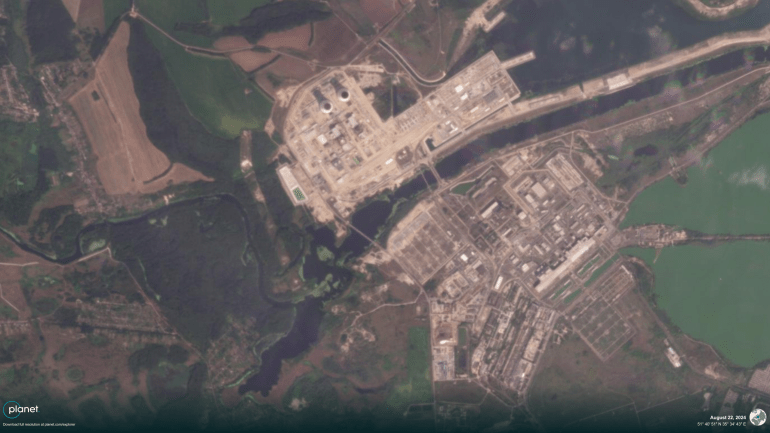IAEA chief visits one of Russia’s nuclear sites after Moscow accused Ukraine of attacking the Kursk power station.
The International Atomic Energy Agency’s (IAEA) Director General Rafael Mariano Grossi is visiting the Kursk nuclear power station, following Russian claims of an attack on the site last week.
In a post on X on Monday Grossi said, “Given the serious situation, I’m personally leading tomorrow’s @IAEAorg mission to the Kursk Nuclear Power Plant in Russia.”
Russia accused Ukraine on Friday of trying to attack the Kursk nuclear power station overnight in what it called an act of “nuclear terrorism”.
Ukraine has not responded to the accusations.
The nuclear plant is located in the Kursk region of western Russia, where fierce fighting has raged since Ukrainian forces launched a surprise incursion on August 6, hitting back as Russian troops advance in eastern Ukraine.
The IAEA said in a statement it had been informed by Russia that the remains of a drone were found within the area of the nuclear power plant, located roughly 100 metres (328 feet) from the plant’s spent fuel nuclear storage facility.
![Kursk Nuclear Power Station, August 22, 2024 [Planet Labs]](https://www.aljazeera.com/wp-content/uploads/2024/08/planet-After-2024-08-22-1724764616.png?w=770&resize=770%2C433)
Where is fighting taking place?
Ukraine estimates it has seized 1,263sq km (488sq miles) of Russian territory so far.
On Sunday, Ukrainian President Volodymyr Zelenskyy said his forces had gained up to three kilometres (1.86 miles) in the Kursk region, taking control of two more settlements there.
Amid the intense fighting, concerns have been growing following claims of the drone attack at Kursk Nuclear Power Plant (NPP). This comes just weeks after fighting in Sudzha raised concerns due to the location of the only pumping station for Russian natural gas to reach Europe through Ukraine.

Where are Russia’s nuclear sites?
Russia operates at least 37 nuclear reactors across 11 nuclear power plants. The Kursk plant, located about 100km (62 miles) from the Ukrainian border, is among the three largest nuclear facilities in the country.
Kursk NPP is just 40km (25 miles) away from the recent fighting and has four Soviet RBMK-1000 reactors – the same design as those at the Chernobyl nuclear plant which in 1986 became the scene of the world’s worst civilian nuclear disaster. The two working nuclear reactors -number 3 and 4 – generate 90 percent of the Kursk region’s total power generation capacity.

The IAEA has said that during Grossi’s visit, they will assess the site and evaluate the nuclear safety and security conditions at the power plant.
“Military activity in the vicinity of a nuclear power plant is a serious risk to nuclear safety and security. My visit to KNPP next week will provide us with timely access to independently assess the situation,” Grossi said on Thursday.
Construction of the Kursk-2 power plant is under way, using essentially new reactors of the VVER-510 type, which began in 2018. However, the two reactors are not operational yet.
Where are Ukraine’s nuclear sites?
Ukraine has 15 nuclear reactors across four NPPs. Zaporizhzhia accounts for nearly half of the total electricity generated by Ukraine’s NPPs and one-fifth (20 percent) of its annual electricity production.
Since the start of the Russia-Ukraine war, concerns for Zaporizhzhia NPP, located in the southern Ukrainian steppe on the Dnipro River, 550km (342 miles) southeast of Ukraine’s capital, Kyiv, have continuously been raised after it was captured by Russian forces in March 2022.
The IAEA has stated it has staff continuously present at all of Ukraine’s nuclear sites to monitor their safety and security.

How reliant are Ukraine and Russia on nuclear power?
In 2023, more than half (50.7 percent) of Ukraine’s electricity was produced with nuclear power, followed by coal (20.9 percent), hydropower (12.3 percent) and gas (7.8 percent).
In 2023, 45 percent of Russia’s electricity came from gas, while only 18.4 percent of its electricity came from nuclear power.
Russia is the second-largest exporter of natural gas. Christoph Halser, an analyst with Oslo-based Rystad Energy, told Al Jazeera the share of Russian gas as part of total European imports has more than halved from 38 percent in 2021 to 15 percent in 2023.
Despite the war with Russia, Kyiv has allowed the gas to continue being sent through its Soviet-era gas pipeline unabated.
EMEA Tribune is not involved in this news article, it is taken from our partners and or from the News Agencies. Copyright and Credit go to the News Agencies, email news@emeatribune.com Follow our WhatsApp verified Channel





